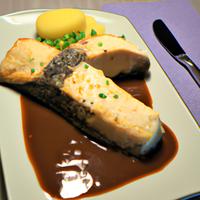
1 serving (100 grams) contains 81 calories, 17.5 grams of protein, 0.9 grams of fat, and 0.0 grams of carbohydrates.

Log this food in SnapCalorie

Nutrition Information
Calories |
192.9 | ||
|---|---|---|---|
% Daily Value* |
|||
| Total Fat | 2.1 g | 2% | |
| Saturated Fat | 0.5 g | 2% | |
| Polyunsaturated Fat | 0 g | ||
| Cholesterol | 119.0 mg | 39% | |
| Sodium | 142.9 mg | 6% | |
| Total Carbohydrates | 0 g | 0% | |
| Dietary Fiber | 0 g | 0% | |
| Sugars | 0 g | ||
| protein | 41.7 g | 83% | |
| Vitamin D | 0 mcg | 0% | |
| Calcium | 26.2 mg | 2% | |
| Iron | 0.7 mg | 3% | |
| Potassium | 714.3 mg | 15% | |
* Percent Daily Values are based on a 2,000 calorie diet. Your daily values may be higher or lower depending on your calorie needs.
Food Attributes
Source of Calories
About Seelachsfilet
Seelachsfilet, known as pollock fillet in English, is a flavorful seafood option popular in German and European cuisine. Derived from the Alaska pollock, a cold-water fish, it features a mild taste and flaky texture, making it versatile for various recipes like grilling, baking, or pan-frying. Low in calories and high in protein, Seelachsfilet is an excellent source of vital nutrients such as omega-3 fatty acids, B vitamins, and selenium, which support heart health and brain function. It is naturally low in fat, though preparation methods like breading or frying can increase its fat and calorie content. Often used in fish sticks and processed seafood dishes, it's important to check for added salt or preservatives in pre-packaged versions. An affordable and nutritious choice, Seelachsfilet appeals to those seeking a balanced diet with quality protein from sustainable fish sources.



